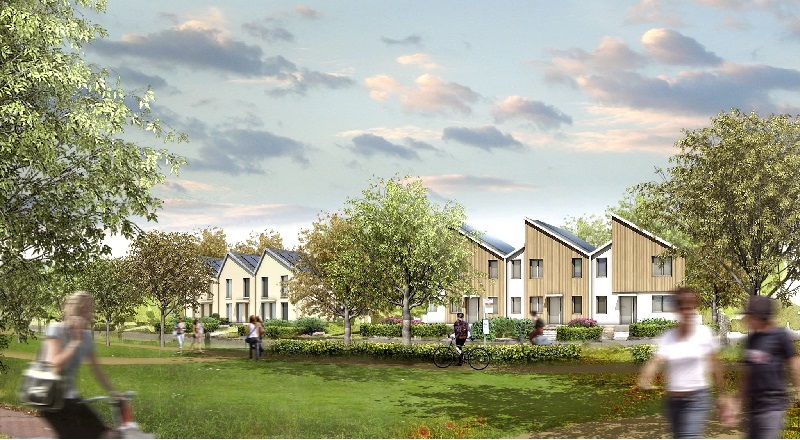A renaissance in the idea of garden villages and towns

|
Contents |
[edit] Introduction
The concept of garden towns or garden villages was first introduced in the UK in 1898 and has continued to modestly grow ever since to be defined as: a free-standing, self-sustaining, high-quality urban space that can address the housing issues and is led by the local authority and supported by the community.
While garden villages/towns are universally seen as a good idea, their relatively slow growth is down to the existing ones failing to be the Utopia they promised to be. This discouraging outcome is rooted in the lack of a mechanism that considers all social and technical impacts of a new development in its context in a wholesome manner.
In this article, we analyse some of the most common problems associated with garden villages/towns, their criticisms, their respective solutions and their relationship to BREEAM Communities methodology.
[edit] Loss of character
Garden villages/towns have been often criticised for not respecting or retaining the original character of the locale they are developed in.
Every region and community holds its own unique characteristics and vernacular. Continuity between architectural style and building design within the development and the surrounding area will create a coalition between the existing and new residents which in turn adds value to the quality of life within that community.
Injecting a new neighbourhood into the countryside with its own facilities and potentially new occupants requires a great deal of scrutiny into the existing and local features through studying the surroundings, as well as undertaking consultations with stakeholders and community representatives. The BREEAM Communities scheme has an assessment issue worth two credits dedicated to the subject of local vernacular to confirm that the development relates to the local character while reinforcing its own identity through a few practical steps.
[edit] Infrastructure
Concentrating new homes in purpose-built new towns or villages has a twofold effect on infrastructure:
- Services and infrastructure (such as new drainage systems and gas and electricity services etc.) are built as part of the development which can upset locals in numerous ways if not done properly. Power loss, road closures, interruptions of customer supply or unnecessary expenses are some of the unwelcome outcomes of an inefficient plan for the existing/surrounding communities. This is addressed under BREEAM Communities’ 'Utilities' assessment issue where three credits are awarded for providing ducting and access points for services, and also for service providers’ coordination to ensure that installation and maintenance do not interrupt consumers’ supply.
- It puts pressure on existing infrastructure and services where no extra infrastructure or services have been provided to support the new homes . The notion of considering communities' needs and requirements in terms of services and facilities and also the delivery of these are visited in a few assessment issues within BREEAM Communities at the very early stages of development.
[edit] Traffic
Milton Keynes, as one of the first new-age garden cities, has over the years been criticised for its grid of broad roads that steers residents towards driving cars rather than using public transport. The grid also frustrates developers by taking up more space than a traditional city street, despite the fact that it distributes traffic.
Other garden villages/towns, on the other hand, seem to have been unable to cope with the traffic load due to poor or no evaluation of the infrastructural needs of a newly built community.
Both of the above cases have led to unhappy stakeholders, whether that is the community or the local authority. Whereas an early consultation with the stakeholders alongside an assessment of the transport situation in the area followed by a design review in line with the results can prevent either of the above issues.
To achieve this BREEAM Communities provides step-by-step guidance to:
- Ensure the needs, ideas and knowledge of the community are used to improve the quality of the design, planning and construction process. (consultation);
- Ensure that the masterplan design is reviewed by the community and other key stakeholders, ensuring that it supports a vibrant, healthy, functional and inclusive development. (governance);
- Ensure transport and movement strategies reduce the impact of the development upon the existing transport infrastructure and improve environmental and social sustainability through transport. (transport and movement).
[edit] Other issues
Overloaded schools and surgeries, a lack of essential facilities such as shops, post offices and banks, and an absence of green infrastructure are some of the other issues that have made the garden city movement unsustainable. These have all resulted from not considering demographic needs in general - which is the core of BREEAM Communities methodology.
Undeniably there are other types of hurdles to building practical garden villages/towns. However, with the government’s financial backing, lessons learned from the previous projects and the sciences within the communities assessment methodology, now is the right time to create garden villages and towns that are, more than ever, environmentally, socially and economically sustainable.
The most commonly accepted number of homes the UK needs to be building each year, in order to meet future housing need, is 240,000. Despite the small increase in the number of newly built homes, we are far from achieving this, hence the Government backing of garden villages. However, the housing crisis is not about how many homes we can build each year, it is about how many of these homes are affordable, habitable and practical for the people and the community. This is where the politically sponsored, sustainably created and socially approved garden villages/towns come into play.
--Atiyeh Rose Pourmatin 10:52, 20 Mar 2018 (BST)
[edit] Related articles on Designing Buildings Wiki
- BREEAM communities.
- British post-war mass housing.
- CIBSE Case Study: Garden City.
- Creating strong communities – measuring social sustainability in new housing development.
- Densification.
- Development corporation.
- Eco Town.
- Garden cities.
- Garden Communities Programme.
- Garden town.
- Garden village.
- Green belt.
- Hamlet.
- Jane Jacobs and garden villages.
- Lyons Housing Review.
- Masterplanning.
- New towns.
- New Town Development Corporation.
- Rural.
- Suburb.
- Town.
Featured articles and news
Homes England supports Greencore Homes
42 new build affordable sustainable homes in Oxfordshire.
Zero carbon social housing: unlocking brownfield potential
Seven ZEDpod strategies for brownfield housing success.
CIOB report; a blueprint for SDGs and the built environment
Pairing the Sustainable Development Goals with projects.
Types, tests, standards and fires relating to external cladding
Brief descriptions with an extensive list of fires for review.
Latest Build UK Building Safety Regime explainer published
Key elements in one short, now updated document.
UKGBC launch the UK Climate Resilience Roadmap
First guidance of its kind on direct climate impacts for the built environment and how it can adapt.
CLC Health, Safety and Wellbeing Strategy 2025
Launched by the Minister for Industry to look at fatalities on site, improving mental health and other issues.
One of the most impressive Victorian architects. Book review.
Common Assessment Standard now with building safety
New CAS update now includes mandatory building safety questions.
RTPI leader to become new CIOB Chief Executive Officer
Dr Victoria Hills MRTPI, FICE to take over after Caroline Gumble’s departure.
Social and affordable housing, a long term plan for delivery
The “Delivering a Decade of Renewal for Social and Affordable Housing” strategy sets out future path.
A change to adoptive architecture
Effects of global weather warming on architectural detailing, material choice and human interaction.
The proposed publicly owned and backed subsidiary of Homes England, to facilitate new homes.
How big is the problem and what can we do to mitigate the effects?
Overheating guidance and tools for building designers
A number of cool guides to help with the heat.
The UK's Modern Industrial Strategy: A 10 year plan
Previous consultation criticism, current key elements and general support with some persisting reservations.
Building Safety Regulator reforms
New roles, new staff and a new fast track service pave the way for a single construction regulator.























